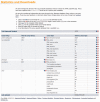Genenames.org: the HGNC resources in 2013
- PMID: 23161694
- PMCID: PMC3531211
- DOI: 10.1093/nar/gks1066
Genenames.org: the HGNC resources in 2013
Abstract
The HUGO Gene Nomenclature Committee situated at the European Bioinformatics Institute assigns unique symbols and names to human genes. Since 2011, the data within our database has expanded largely owing to an increase in naming pseudogenes and non-coding RNA genes, and we now have >33,500 approved symbols. Our gene families and groups have also increased to nearly 500, with ∼45% of our gene entries associated to at least one family or group. We have also redesigned the HUGO Gene Nomenclature Committee website http://www.genenames.org creating a constant look and feel across the site and improving usability and readability for our users. The site provides a public access portal to our database with no restrictions imposed on access or the use of the data. Within this article, we review our online resources and data with particular emphasis on the updates to our website.
Figures




References
Publication types
MeSH terms
Substances
Grants and funding
LinkOut - more resources
Full Text Sources
Other Literature Sources
Medical

